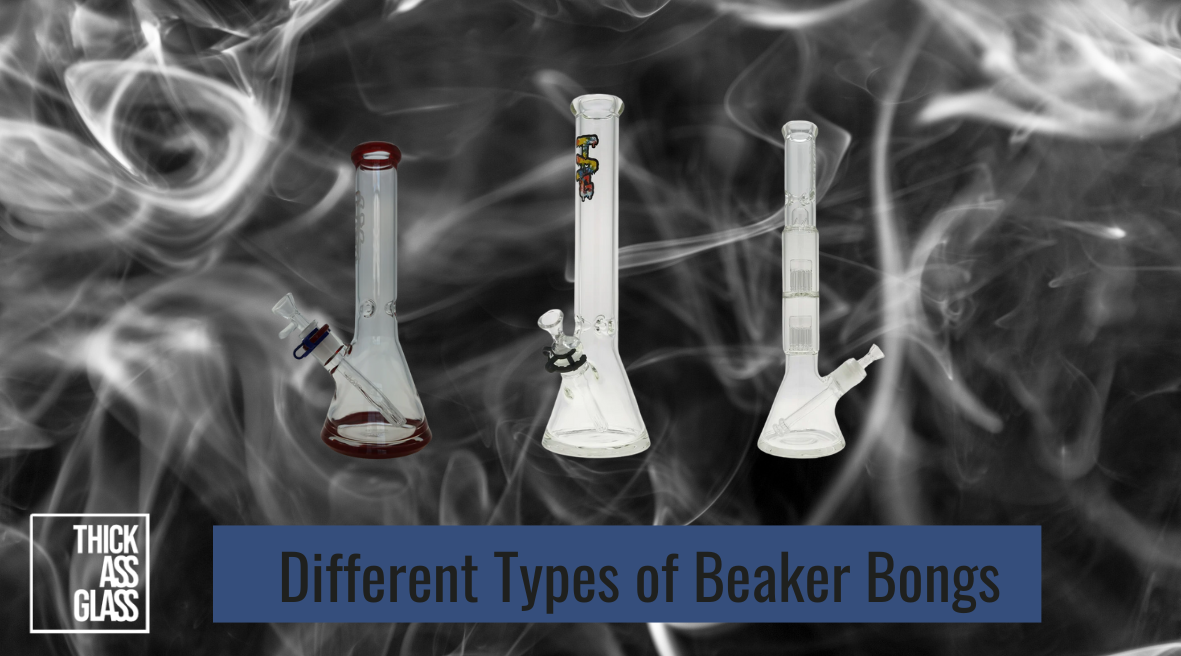Not all beakers hit the same. While they share the same sturdy, wide-base design, their features and functionality can vary wildly. Here's a quick breakdown to help you find the one that fits your setup and session style:
-
Classic Single-Chamber Beaker: A simple, reliable design that’s easy to clean and great for everyday use.
-
Percolator Beaker Bong: Built-in percs smooth out your hits by breaking smoke into smaller bubbles.
-
Multi-Chamber / Dual-Perc Beaker Hybrid: Stacks chambers and filters for ultra-smooth pulls, but takes more effort to clean.
-
Gripper Beaker: Indented neck or waist makes it easier to hold and pass without slipping.
-
Mini Beaker Rig: Small, portable, and perfect for fast clears or flavorful dab sessions.
-
Glass-on-Glass Beaker: Precision joints create a cleaner seal and better airflow—no grommets needed.
-
Metal-Stem Beaker: Tough, low-maintenance, and built to handle rougher use.
If you already own a basic beaker but want to level up, these styles show what’s possible when you move beyond the standard. And if you're just starting out, this list helps you skip the gimmicks and pick a piece that actually performs.
What Makes Beaker Bongs the Gold Standard of Water Pipes?
The shape isn’t just about looks. Beaker bongs are designed with a very clear intention.
That wide, conical base holds more water, which means better smoke cooling and smoother hits. It also makes the piece harder to tip over, especially compared to straight tubes.
If you’ve ever watched someone send a tall bong crashing off a coffee table, you already get the value here. Beakers give you more volume to work with. Bigger rips, less heat, and fewer harsh pulls.
They’re also easy to customize. Most come with removable downstems, giving you the option to swap in higher-end diffusion without changing the whole setup. Add-ons like ash catchers and reclaimers balance better on a beaker than anything with a narrow footprint.
There’s also something satisfying about watching smoke stack in a beaker chamber. You can see the whole process in real time. You know exactly when to pull and clear. Some people care about form, some care about function.
Beakers give you both, without making you pick a side.
Whether you’re at home, outside, or passing it around in a circle, a good beaker stays steady, hits clean, and holds up under pressure.
Main Beaker Bong Types
Beaker bongs are built for different priorities. Some are stripped-down and straightforward, designed to get the job done with minimal effort. Others push airflow and filtration to their limits, stacking chambers and percs for smoother, cooler pulls.
The right type depends on how you like to smoke, how much you want to maintain your piece, and what kind of performance matters most to you.
This breakdown covers the three core styles so you can tell which design lines up with your habits before you commit to something that looks good but hits all wrong.
Classic Single-Chamber Beaker
This is the one most people start with. It's got a clean water chamber, a removable downstem, and usually an ice pinch for cooling. These pieces hit smooth, hold a decent amount of smoke, and rarely break the bank.
That simplicity is part of the appeal. No internal percs to clean, no airflow drag, and just enough volume to cool things down without watering out your hit.
What keeps these popular isn't just price. It's the way they function. The combo of a diffused downstem and ice notches is a proven setup.
Beginners love how easy they are to use. More experienced smokers keep them around because they just work. No surprises, no mess. Just reliable hits every time.
Percolator Beaker Bongs
Add a tree perc, a showerhead, or a honeycomb disc and now you’re working with more than just basic diffusion. Each perc style filters the smoke differently.
Tree percs use glass arms to break up bubbles. Showerheads push smoke through vertical slits. Honeycombs filter using dozens of tiny holes. All three smooth the hit, but each comes with trade-offs.
Tree percs tend to be fragile and harder to clean, especially when built inside a beaker chamber. Showerheads are more durable and easier to rinse. Honeycombs sit flat and usually clog less if the water is changed often.
If you're wondering whether double percs are worth it, they can be. The hit feels more like a breath than a drag, but cleaning takes more effort. Go for it if you’re willing to keep your glass in shape.
Multi-Chamber and Dual-Perc Beaker Hybrids
These are for people chasing smoothness above all else.
More chambers mean more diffusion and more cooling, but also more weight and more maintenance. You’ll need a decent lung capacity to clear a fully stacked beaker. Some smokers find the drag too much, especially with long necks and stacked percs.
Still, when done right, they deliver one of the cleanest hits possible from a water pipe. Are they worth it? If you’re consistent with upkeep and care about performance, absolutely. If you hate cleaning glass, maybe stick to a single chamber and call it a day.
Materials & Construction: Does Thickness Really Matter?
If you care about how your bong performs after the third, tenth, or hundredth session, glass quality should be the first thing you look at.
Borosilicate is the standard for a reason. It handles heat better, resists cracking, and holds its structure longer than the cheaper soda-lime glass used in low-cost imports. For daily smokers, that difference shows up fast.
Now, thickness. A 3mm wall might hold up for a few months if you never bump it. A 5mm or 7mm wall gives you more security. But once you hit 9mm and beyond, everything changes. The weight adds stability, the joint welds become less fragile, and you feel it every time you set the piece down.
TAG beakers go even further, with bases up to 16mm thick. That kind of build does not flinch when loaded with a heavy ash catcher or pulled through a long session.
Still, thick glass alone doesn't guarantee quality.
Some brands slap on extra layers without improving the welds or airflow. It ends up feeling like dead weight. A properly built beaker needs consistency from the base to the mouthpiece. That includes the downstem fitting, the joint seals, and the cut on the mouth rim.
These are the spots where lower-end glass usually fails.
Downstems, Joints, and Ice Catchers: The Real MVPs of Your Beaker Setup
The main chamber gets all the attention, but most of the performance in a beaker comes from the small parts. Downstems, joints, and ice catchers can either make the whole thing sing or drag the experience down. These features are where airflow is shaped, cooling is controlled, and customization happens.
They might seem like details, but they carry more weight than most people realize when choosing or upgrading a piece.
The Downstem Dilemma
Fixed downstems are cleaner by design and eliminate weak points, but they’re locked in. If the airflow feels off or cleaning becomes a hassle, you’re stuck with it.
Removable downstems let you switch things up, clean them separately, and try different diffusion styles without replacing the whole piece. That flexibility is why most well-designed beakers stick with removable stems.
The trick is sizing. Too short and your stem barely touches water.
Too long and it jams against the wall or floods your chamber. For a 12 inch beaker, the right downstem is usually around four and a half inches, but always measure from the bottom of the joint to the end of the stem that sits inside the chamber. Guessing leads to wasted parts and bad airflow.
Thick Ass Glass made a commitment to super-slit downstems that change the game entirely.
Compared to standard cuts, they break smoke into finer bubbles and reduce pull resistance. The hit feels smoother, the stack builds faster, and the water does more work with less effort.
Ice Catchers: Overrated or Necessary?
Ice pinches hold cubes right in the neck, giving smoke extra time to cool before it hits your throat. The difference is easy to notice, especially with bigger pulls.
Some smokers prefer this over stacked percs because the cooling is sharper and the hit stays flavorful.
As for the best cube size, aim for medium to small chunks that sit snug in the pinches without melting too fast or blocking airflow. Crushed ice is too messy, and oversized cubes can get stuck or crack the glass.
Niche Beaker Styles You’ve Probably Never Tried
Most smokers stick to standard beakers because they’re reliable, but there’s a category of builds designed with sharper intent. These pieces exist to solve specific problems. Some improve handling. Others tighten airflow or make better use of heat.
Each one brings something real to the table that standard designs often miss.
Here are a few standout styles worth knowing:
-
Gripper Beaker: Features an indented neck or waist for secure handling. Ideal for standing use or passing around without slipping. Clean design, better ergonomics.
-
Mini Beaker Rig: Compact and perfect for dabs or small bowls. Delivers strong flavor and fast clears. Best suited for microdosing and travel sessions.
-
Glass-on-Glass Beaker: Uses precision-cut joints without rubber grommets. Creates a seamless seal that improves airflow and eliminates wear points.
-
Metal-Stem Beaker: Durable and low-maintenance. Still common in places where function outweighs diffusion. Easy to replace and tough enough for rough use.
If your setup already works but feels limited, one of these might fill the gap.
They’re not style over substance. They’re the kind of designs that come from people who use their gear hard and pay attention to what matters.
Best-in-Class Beaker Bong Recommendations
A good beaker bong should match how you smoke.
Size, airflow, and accessories all play a role in how the piece performs. That’s why we don’t recommend one-size-fits-all options. Instead, it makes more sense to break things down by price tier. Every level has pieces worth owning, as long as they’re built right.
Here are three that stand out for build quality, function, and value.
Under $100: Entry-Level
This piece is a workhorse. At this price, most bongs come with thin walls and weak diffusion, but not this one. The base is thick enough to stay stable on any surface, and the super-slit downstem provides noticeable smoothness right out of the box.
It’s compact, reliable, and easy to clean. This is the one to keep in rotation or travel with.
$100 to $200: The Sweet Spot
16 inch TAG Beaker with 14MM reinforced joint
This is where performance meets durability. The reinforced joint adds strength where most bongs break. The bowl is designed for better airflow and even combustion, and the ice catcher is positioned to keep hits cool without blocking the chamber.
The 12mm thick base keeps everything balanced, even with a large slide or ash catcher.
$200 and Up: Pro-Level Function and Filtration
TAG 20 inch Double Fixed Tree-Arm Beaker
This is a showpiece that performs like a daily driver. Two sets of tree percs stack bubbles without killing airflow. The splash guard protects your pull from dirty water, and the ice notches give the smoke one last cool down before it hits your lungs.
Every part of this design is tuned for airflow and control.
Why the Beaker Will Never Go Out of Style
Some designs fade when trends shift. The beaker keeps showing up because it was never chasing attention. It solves real problems that smokers care about, including stability, airflow, and the freedom to mod your setup without wrecking the balance.
Whether you’re ripping flower, dropping a dab, or just passing something reliable around with friends, the beaker delivers a session that feels consistent and clean.
It scales with your habits. You can keep it simple or go deep with precision parts and stacked percs. You can go short for portability or tall for monster hits. You get room to upgrade without starting from scratch.
That kind of range isn’t easy to find in glass, and that’s why the shape sticks.
Don’t stay at the level of theory, take a look at the beaker collection at Thick Ass Glass. You’ll find real thickness, tested airflow, and builds that don’t need a sales pitch to prove their value.


